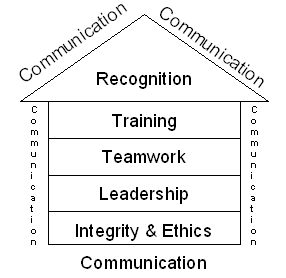
TQM, or Total Quality Management, is a management approach that originated in the 1950s and has steadily become more popular since the early 1980s. This approach encompasses the culture, attitude, and organization of a company. Further, it helps to provide customers with products and services that satisfy their needs. However, the culture requires quality in all aspects of the company’s operations, with processes being done right the first time and defects and waste eradicated from operations.
The Key Elements of TQM
To be successful implementing TQM, an organization must concentrate on eight elements:
- Ethics
- Integrity
- Trust
- Training
- Teamwork
- Leadership
- Recognition
- Communication
Breaking Down the Elements of TQM
 TQM has been coined to describe a philosophy that makes quality the driving force behind leadership, design, planning, and improvement initiatives. Subsequently, TQM requires the help of those eight key elements. As such, these elements can be divided into four groups according to their function. The groups are:
TQM has been coined to describe a philosophy that makes quality the driving force behind leadership, design, planning, and improvement initiatives. Subsequently, TQM requires the help of those eight key elements. As such, these elements can be divided into four groups according to their function. The groups are:
- Foundation – Ethics, Integrity, and Trust.
- Building Bricks – Training, Teamwork, and Leadership.
- Binding Mortar – Communication.
- Roof – Recognition.
Foundation

TQM is built on a foundation of ethics, integrity, and trust. It fosters openness, fairness, and sincerity and allows involvement by everyone. Further, this is the key to unlocking the ultimate potential of TQM. These three elements move together. However, each element offers something different to the TQM concept.
Ethics
The discipline concerned with good and bad in any situation. It is a two-faceted subject represented by organizational and individual ethics. Further, organizational ethics establish a business code of ethics that outlines guidelines that all employees are to adhere to in the performance of their work.
Integrity
This implies honesty, morals, values, fairness, adherence to the facts, and sincerity. Integrity characteristic is what customers (internal or external) expect and deserve to receive. People see the opposite of integrity as duplicity.
Trust
Trust is a by-product of integrity and ethical conduct. Without trust, the framework of TQM cannot be built. Trust fosters the full participation of all members. Subsequently, it allows empowerment that encourages pride ownership and it encourages commitment.
Building Bricks

Based on the strong foundation of trust, ethics, and integrity, bricks are placed to reach the roof of recognition. It includes:
Training
Training is very important for employees to be highly productive. Supervisors are solely responsible for implementing and teaching their employees the philosophies of TQM. Training that employees require is interpersonal skills, the ability to function within teams, problem-solving, decision-making, job management performance analysis and improvement, business economics, and technical skills.
Teamwork
To become successful in business, teamwork is also a key element of TQM. With the use of teams, the business will receive quicker and better solutions to problems. Further, teams also provide more permanent improvements in processes and operations. Using TQM you can divide into specific teams like the following:
- Quality improvement teams or excellence teams (QITs) – Temporary teams to deal with specific problems that often recur.
- Problem-solving teams (PSTs) – Temporary teams to solve certain problems and also to identify and overcome causes of problems.
- Natural work teams (NWTs) – Teams consisting of small groups of skilled workers who share tasks and responsibilities. They’ll focus on concepts such as employee involvement teams, self-managing teams, and quality circles.
Leadership
It is possibly the most important element in TQM. It appears everywhere in an organization. Leadership in TQM requires the manager to provide an inspiring vision, make strategic directions that are understood by all, and instill values that guide subordinates. TQM has to be introduced and led by top management. Commitment and personal involvement are required from top management in creating and deploying clear quality values and goals.
Binding Mortar

Communication is the most crucial element. Starting from the foundation to the roof of the TQM house, everything is bound by a strong mortar of communication. It acts as a vital link between all elements of TQM. However, the success of TQM demands communication with and among all the organization members, suppliers, and customers. Supervisors must keep open airways where employees can send and receive information about the TQM process. As such, communication coupled with the sharing of correct information is vital.
There are different ways of communication such as:
- Downward communication – This is the dominant form of communication in an organization. Presentations and discussions do it. By this, the supervisors can make the employees clear about TQM.
- Upward communication – By this the lower level of employees can provide suggestions to upper management on the effects of TQM. As employees provide insight and constructive criticism, supervisors must listen effectively to correct the situation that comes about through the use of TQM. This forms a level of trust between supervisors and employees. This is also similar to empowering communication, where supervisors keep open ears and listen to others.
- Sideways communication – This type of communication is important because it breaks down barriers between departments. It also allows dealing with customers and suppliers more professionally.
Roof

Recognition is the last and final element in the entire system. It should be provided for both suggestions and achievements for teams as well as individuals. However, detecting and recognizing contributors is the most important job of a supervisor. As people are recognized, there can be huge changes in self-esteem, productivity, quality, and the amount of effort exerted on the task at hand. Further, recognition comes in different ways, places, and times such as:
- Ways – It can be by way of a personal letter from top management. Also by award banquets, plaques, trophies etc.
- Places – Good performers can be recognized in front of departments, on performance boards, and also in front of top management.
- Time – Recognition can be given at any time like in staff meetings, annual award banquets, etc.
TQM in the News
A recent research paper authored by Zhiyuan Hu, Richard Szewei Wang, and others has taken a closer look at Total Quality Management and how it applies to the future of healthcare. TQM is a driving force in healthcare, as few industries are so people-centric. However, Hu and his colleagues postulate that the future of healthcare is intrinsically tied to risk management and a stronger foundation built upon Total Quality Management.
Additional Approaches to Bolster Your Productivity
While TQM is great for improving all aspects of your organization, you might want to take a look at some other approaches. For instance, using B10 Life focuses on quality and reliability, as can be seen in our in-depth guide covering the subject.
Further, you might want to look at DPO and how it applies to your production line. Considering defects is a vital part of any workflow, especially when operating at scale. Our guide covers the ins and outs of the nomenclature and how it applies to your workflow.
Tying It All Together
We can conclude that these eight elements are key in ensuring the success of TQM in an organization and that the supervisor plays a huge part in developing these elements in the workplace. Further, TQM is a valuable means of managing your teams. It benefits both your customers and your employees. After all, an ethical team is going to lead to satisfied customers. TQM’s implementation also makes sure your employees are recognized and rewarded for their hard work.